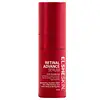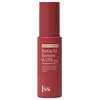What's inside
What's inside
 Key Ingredients
Key Ingredients

 Benefits
Benefits

 Concerns
Concerns

 Ingredients Side-by-side
Ingredients Side-by-side

Water
Skin ConditioningPentylene Glycol
Skin ConditioningPropanediol
SolventNiacinamide
SmoothingDipropylene Glycol
HumectantGlycerin
HumectantAlpha-Arbutin
AntioxidantHydrolyzed Collagen
EmollientRetinal
Skin ConditioningAscorbic Acid
AntioxidantPhospholipids
Skin ConditioningCaprylic/Capric Triglyceride
MaskingSodium Palmitoyl Proline
Skin ConditioningNymphaea Alba Flower Extract
Skin ConditioningButylene Glycol
HumectantCeteareth-25
CleansingCetyl Alcohol
EmollientBehenic Acid
CleansingCholesterol
EmollientCeramide NP
Skin ConditioningCeramide Ns
Skin ConditioningCeramide Eos
Skin ConditioningCeramide EOP
Skin ConditioningCeramide AP
Skin ConditioningCaprooyl Phytosphingosine
Skin ConditioningCaprooyl Sphingosine
Skin ConditioningEthylhexylglycerin
Skin ConditioningPhenoxyethanol
PreservativeAscorbyl Palmitate
AntioxidantTocopherol
AntioxidantLecithin
EmollientGlyceryl Stearate
EmollientGlyceryl Oleate
EmollientCitric Acid
BufferingNicotiana Benthamiana Hexapeptide-40 Sh-Polypeptide-76
Skin ConditioningChamomilla Recutita Flower Extract
MaskingSodium Benzoate
MaskingPotassium Sorbate
PreservativeAcetyl Hexapeptide-8
HumectantTetradecyl Aminobutyroylvalylaminobutyric Urea Trifluoroacetate
Skin ConditioningMagnesium Chloride
Palmitoyl Tripeptide-5
Skin ConditioningCalendula Officinalis Flower Extract
MaskingPropylene Glycol
HumectantAsparagopsis Armata Extract
Skin ProtectingAmmonium Acryloyldimethyltaurate/Vp Copolymer
Hibiscus Sabdariffa Callus Extract
AntioxidantXanthan Gum
EmulsifyingPalmitoyl Hexapeptide-52
Skin ConditioningLactic Acid/Glycolic Acid Copolymer
Skin ConditioningPolyvinyl Alcohol
Palmitoyl Heptapeptide-18
Skin ConditioningCaprylyl Glycol
EmollientGlyceryl Caprylate
EmollientPhenylpropanol
MaskingOligopeptide-1
Skin ConditioningSqualane
EmollientUbiquinone
AntioxidantTocopheryl Acetate
AntioxidantHydroxyethylcellulose
Emulsion StabilisingDisodium Phosphate
BufferingSodium Phosphate
BufferingPolysorbate 60
EmulsifyingSodium Nitrate
SoothingGlyoxal
AntimicrobialEthoxydiglycol
HumectantHyaluronic Acid
HumectantWater, Pentylene Glycol, Propanediol, Niacinamide, Dipropylene Glycol, Glycerin, Alpha-Arbutin, Hydrolyzed Collagen, Retinal, Ascorbic Acid, Phospholipids, Caprylic/Capric Triglyceride, Sodium Palmitoyl Proline, Nymphaea Alba Flower Extract, Butylene Glycol, Ceteareth-25, Cetyl Alcohol, Behenic Acid, Cholesterol, Ceramide NP, Ceramide Ns, Ceramide Eos, Ceramide EOP, Ceramide AP, Caprooyl Phytosphingosine, Caprooyl Sphingosine, Ethylhexylglycerin, Phenoxyethanol, Ascorbyl Palmitate, Tocopherol, Lecithin, Glyceryl Stearate, Glyceryl Oleate, Citric Acid, Nicotiana Benthamiana Hexapeptide-40 Sh-Polypeptide-76, Chamomilla Recutita Flower Extract, Sodium Benzoate, Potassium Sorbate, Acetyl Hexapeptide-8, Tetradecyl Aminobutyroylvalylaminobutyric Urea Trifluoroacetate, Magnesium Chloride, Palmitoyl Tripeptide-5, Calendula Officinalis Flower Extract, Propylene Glycol, Asparagopsis Armata Extract, Ammonium Acryloyldimethyltaurate/Vp Copolymer, Hibiscus Sabdariffa Callus Extract, Xanthan Gum, Palmitoyl Hexapeptide-52, Lactic Acid/Glycolic Acid Copolymer, Polyvinyl Alcohol, Palmitoyl Heptapeptide-18, Caprylyl Glycol, Glyceryl Caprylate, Phenylpropanol, Oligopeptide-1, Squalane, Ubiquinone, Tocopheryl Acetate, Hydroxyethylcellulose, Disodium Phosphate, Sodium Phosphate, Polysorbate 60, Sodium Nitrate, Glyoxal, Ethoxydiglycol, Hyaluronic Acid
Water
Skin ConditioningGlycerin
HumectantTriethylhexanoin
MaskingLactobacillus/Collagen/Mesembryanthemum Crystallinum Leaf Extract Ferment Lysate
Skin ConditioningCaprylic/Capric Triglyceride
MaskingPropylene Glycol
HumectantPolysorbate 80
EmulsifyingCentella Asiatica Leaf Extract
Skin ConditioningCetyl Alcohol
EmollientGlyceryl Stearate
EmollientPhenoxyethanol
PreservativeRetinal
Skin ConditioningPEG-7 Glyceryl Cocoate
EmulsifyingCeramide NP
Skin ConditioningSodium Hyaluronate
HumectantCrithmum Maritimum Extract
Skin ConditioningTromethamine
BufferingPolyglutamic Acid
Skin ConditioningHydrolyzed Hyaluronic Acid
HumectantHydroxypropyltrimonium Hyaluronate
Butylene Glycol
HumectantSucrose Laurate
Emollient1,2-Hexanediol
Skin ConditioningHydroxyacetophenone
AntioxidantInulin Lauryl Carbamate
Emulsion StabilisingSodium Acetylated Hyaluronate
HumectantPEG-75 Stearate
Water, Glycerin, Triethylhexanoin, Lactobacillus/Collagen/Mesembryanthemum Crystallinum Leaf Extract Ferment Lysate, Caprylic/Capric Triglyceride, Propylene Glycol, Polysorbate 80, Centella Asiatica Leaf Extract, Cetyl Alcohol, Glyceryl Stearate, Phenoxyethanol, Retinal, PEG-7 Glyceryl Cocoate, Ceramide NP, Sodium Hyaluronate, Crithmum Maritimum Extract, Tromethamine, Polyglutamic Acid, Hydrolyzed Hyaluronic Acid, Hydroxypropyltrimonium Hyaluronate, Butylene Glycol, Sucrose Laurate, 1,2-Hexanediol, Hydroxyacetophenone, Inulin Lauryl Carbamate, Sodium Acetylated Hyaluronate, PEG-75 Stearate
 Reviews
Reviews

Ingredients Explained
These ingredients are found in both products.
Ingredients higher up in an ingredient list are typically present in a larger amount.
Butylene Glycol (or BG) is used within cosmetic products for a few different reasons:
Overall, Butylene Glycol is a safe and well-rounded ingredient that works well with other ingredients.
Though this ingredient works well with most skin types, some people with sensitive skin may experience a reaction such as allergic rashes, closed comedones, or itchiness.
Learn more about Butylene GlycolThis ingredient is an emollient, solvent, and texture enhancer. It is considered a skin-softener by helping the skin prevent moisture loss.
It helps thicken a product's formula and makes it easier to spread by dissolving clumping compounds.
Caprylic Triglyceride is made by combining glycerin with coconut oil, forming a clear liquid.
While there is an assumption Caprylic Triglyceride can clog pores due to it being derived from coconut oil, there is no research supporting this.
Learn more about Caprylic/Capric TriglycerideCeramide NP is a type of ceramide and formally known as ceramide 3.
Ceramides are intercellular lipids naturally found in our skin that bonds dead skin cells together to create a barrier. They are known for their ability to hold water and thus are a great ingredient for dry skin.
Ceramides are an important building block for our skin barrier. A stronger barrier helps the skin look more firm and hydrated. By bolstering the skin ceramides act as a barrier against irritating ingredients. This can help with inflammation as well.
If you would like to eat ceramides, sweet potatoes contain a small amount.
Read more about other common types of ceramides here:
Ceramide AP
Ceramide EOP
Cetyl Alcohol is a fatty alcohol. Fatty Alcohols are most often used as an emollient or to thicken a product.
Its main roles are:
Though it has "alcohol" in the name, it is not related to denatured alcohol or ethyl alcohol.
The FDA allows products labeled "alcohol-free" to have fatty alcohols.
Learn more about Cetyl AlcoholGlycerin is already naturally found in your skin. It helps moisturize and protect your skin.
A study from 2016 found glycerin to be more effective as a humectant than AHAs and hyaluronic acid.
As a humectant, it helps the skin stay hydrated by pulling moisture to your skin. The low molecular weight of glycerin allows it to pull moisture into the deeper layers of your skin.
Hydrated skin improves your skin barrier; Your skin barrier helps protect against irritants and bacteria.
Glycerin has also been found to have antimicrobial and antiviral properties. Due to these properties, glycerin is often used in wound and burn treatments.
In cosmetics, glycerin is usually derived from plants such as soybean or palm. However, it can also be sourced from animals, such as tallow or animal fat.
This ingredient is organic, colorless, odorless, and non-toxic.
Glycerin is the name for this ingredient in American English. British English uses Glycerol/Glycerine.
Learn more about GlycerinGlyceryl Stearate is a mix of glycerin and stearic acid.
It is used to stabilize the mixing of water and oil ingredients. By preventing these ingredients from separating, it can help elongate shelf life. It can also help thicken the product's texture.
As an emollient, it helps soften skin and supports barrier-replenishing ingredients.
In cosmetics, Glyceryl Stearate is often made from vegetable oils or synthetically produced.
This ingredient may not be fungal-acne safe
Fun fact: The human body also creates Glyceryl Stearate naturally.
Learn more about Glyceryl StearatePhenoxyethanol is a preservative that has germicide, antimicrobial, and aromatic properties. Studies show that phenoxyethanol can prevent microbial growth. By itself, it has a scent that is similar to that of a rose.
It's often used in formulations along with Caprylyl Glycol to preserve the shelf life of products.
Propylene Glycol is an odorless, colorless liquid. As a humectant, it helps skin retain moisture. It also aids in delivering active ingredients.
Another role of this ingredient is preventing a product from melting or freezing. Propylene glycol also adds antimicrobrial properties to a product, elongating product lifespan.
This ingredient is considered an organic alcohol and commonly added into both cosmetics and foods.
Those with sensitive skin or conditions may develop a rash when using this ingredient.
Learn more about Propylene GlycolRetinal is a form of retinoid. Retinoids are the gold-standard class of anti-aging ingredients.
Retinal has many benefits as other retinoids: improve skin texture, reduce large pores, reduce the effects of aging, reduce the visibility of dark spots, heal scars, and fight acne.
Studies show retinal may work at a faster rate than retinol due to its structure.
All retinoids have to be converted into retinoic acid before starting to work. Some retinoids take several steps of conversion before binding. Retinal is only one step away, making it more potent.
Like other retinoids, retinal may be irritating. It is best to ease into using this ingredient frequently.
Using the 'ramp up' method, start by using retinol once a week. This gives your skin time to adjust and decrease irritation. Once you feel ready, you can slowly increase the frequency of retinol use.
Using retinoids will increase sun-sensitivity in the first few weeks of use. Though studies show retinoids increase your skin's natural SPF with continuous use, it is best to always wear sunscreen and sun-protection.
Learn more about RetinalWater. It's the most common cosmetic ingredient of all. You'll usually see it at the top of ingredient lists, meaning that it makes up the largest part of the product.
So why is it so popular? Water most often acts as a solvent - this means that it helps dissolve other ingredients into the formulation.
You'll also recognize water as that liquid we all need to stay alive. If you see this, drink a glass of water. Stay hydrated!
Learn more about Water